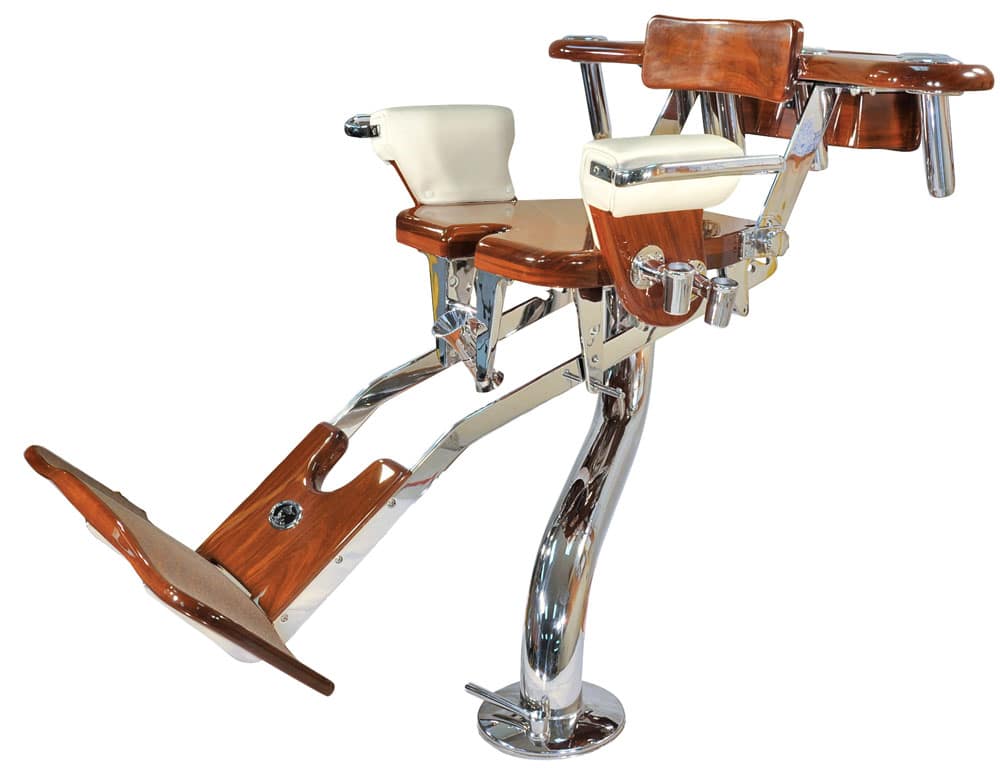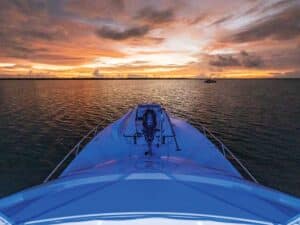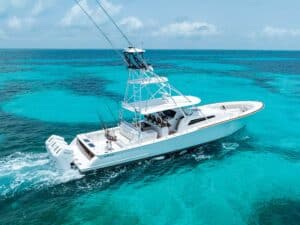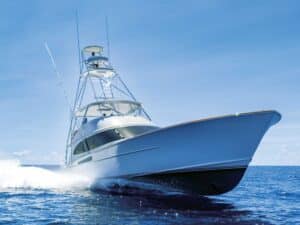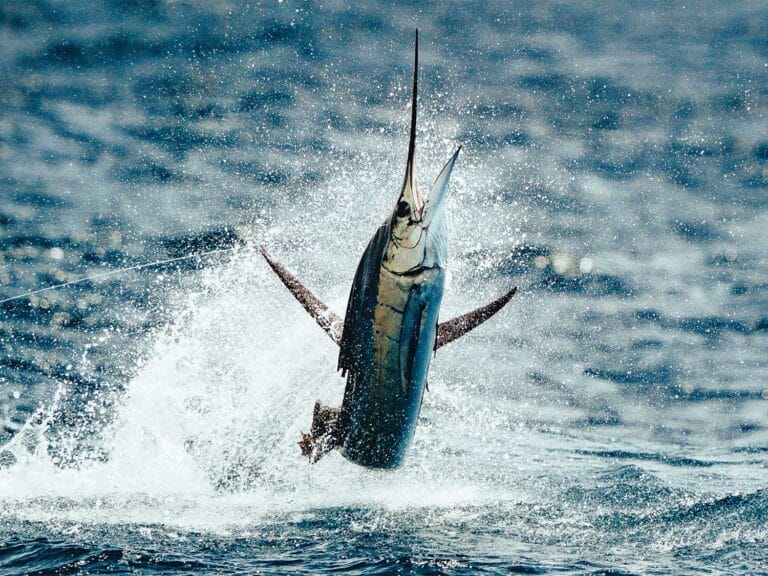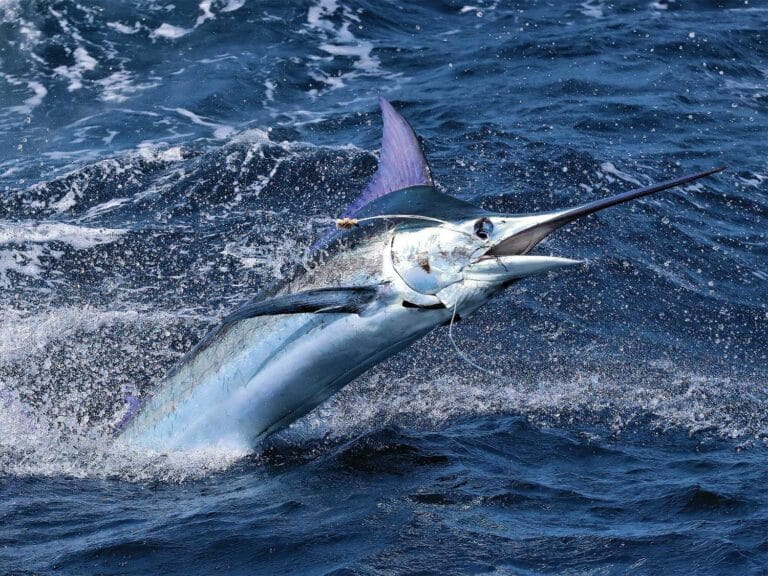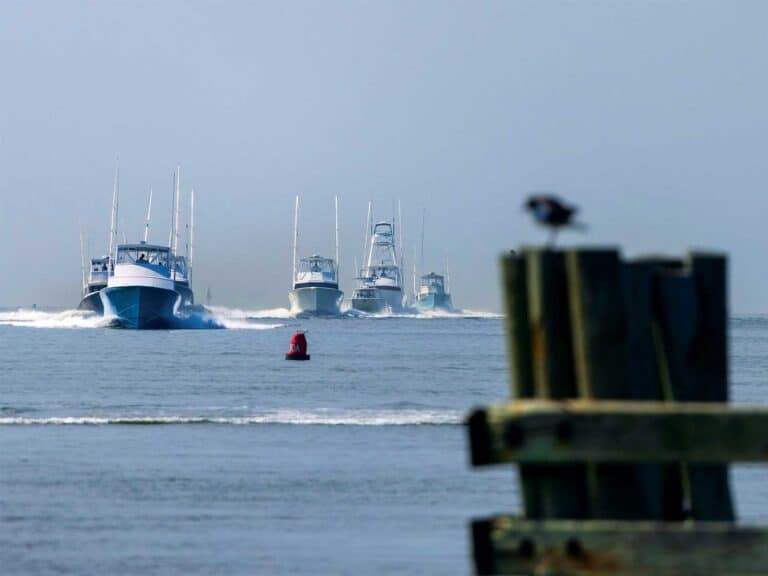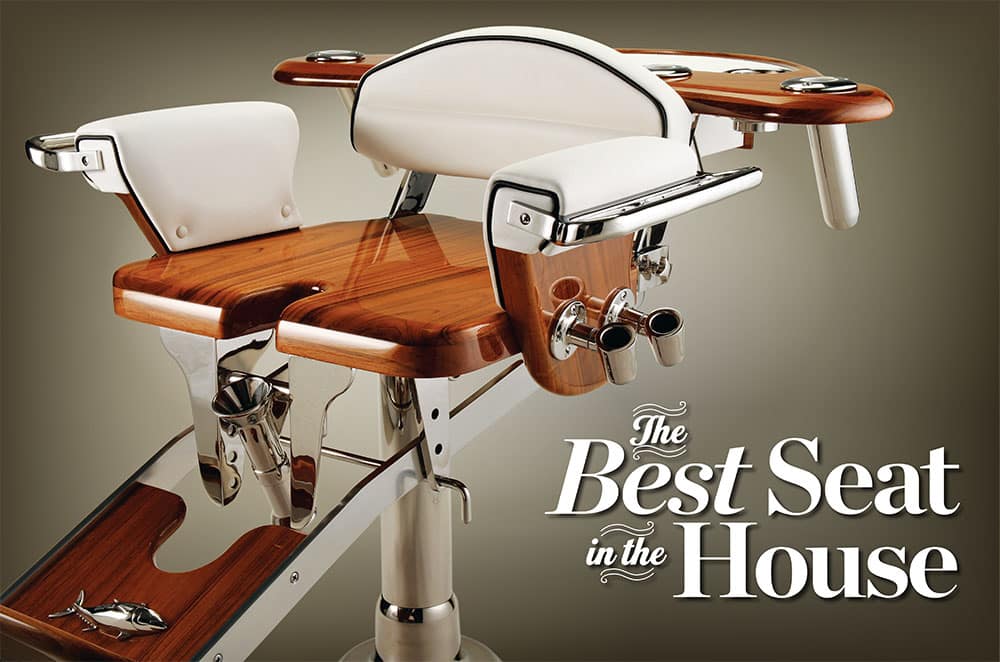
As a technological advancement, the fighting chair outranks even the outrigger and the tuna tower; after all, there’s not much use in seeing and hooking big game fish like bluefin tuna if there’s no way to use the heavy tackle required for the fight. Fighting chairs allow anglers of all shapes and sizes to battle the world’s largest marlin and tuna in relative comfort. Some are stunning masterpieces of gleaming teak and stainless steel that cost well into the five figures, while others are built to withstand the rigors of charter fishing 250 or more days a year. Either way, the fishing fighting chair remains the best seat in the house.
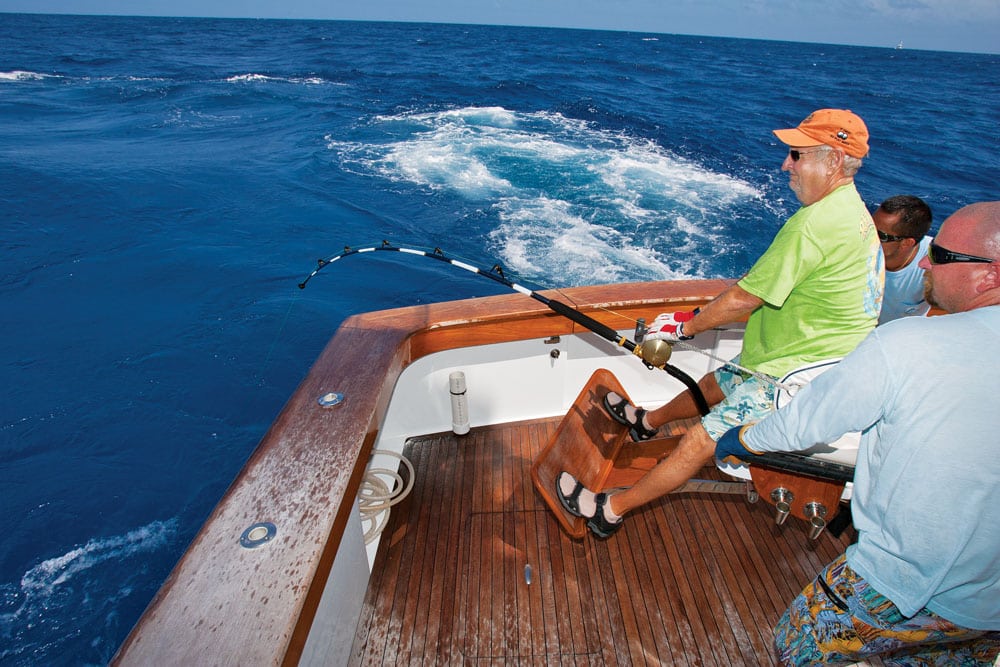
The Early Years of Fighting Chairs for Boats
Check the cockpit of just about any top-flight sport-fishing operation and nine times out of 10, you’ll find a fighting chair sturdily through-bolted to the deck. The first chairs dated back to the earliest days of heavy-tackle game fishing and were constructed mostly of metal. Big-game legend Frank Murray says the early chairs were used primarily for bluefin tuna fishing off Nova Scotia, Canada, before they gained favor with anglers in the Northeast. Strength was the main consideration back in those days, not good looks.
“We bought a 41-foot Hatteras in 1962,” Murray says. “It wasn’t our first boat, but it was one of the first fiberglass boats. We needed a sturdy chair on board, so we installed a Rockaway.” Murray says that the Rockaway chair was indeed strong, but it was also heavy and uncomfortable. The flat metal seat would dig into the back of an unlucky angler’s thighs during the fight.
Within a few years, there were other boats in Montauk, New York, and Gloucester, Massachusetts, notably the Ryboviches and Merritts, that sported beautiful teak fighting chairs. Being woodworkers in the cabinet business, Frank Murray and his brother, Ed, decided to build their own chairs from teak. Knowing it had to be strong enough to handle the heaviest tackle, they insisted on through-bolting all the accessories, a practice that’s still widely used today. They also cut curves into the leading edges of their seats for comfort, a big leap forward from the old Rockaway design.
“We even used some of the hardware that John Rybovich had developed for his chairs,” Frank Murray says. “We had no intention of doing this for a living, but the next thing we knew, we were in the fighting-chair business.” In 1990, Ed Murray retired and he and Frank sold the tackle business along with the name Murray Brothers, but the family kept producing Murray fighting chairs, renaming it Murray Products. Today the company is run by the next generation of Murrays — Vincent and Michael, along with their sister, Lynn.
The Classic Teak Fighting Chair for Fishing Boats
The construction of a modern fighting chair depends on several factors, generally starting with the products used. Teak is overwhelmingly the most popular choice in hardwoods, but injection-molded resin is also a very popular option. Synthetic chairs are less expensive to produce and require less maintenance. They match boats that do not have teak in the cockpit and are more durable, making them perfect for hard-fishing charter operations. For the moment, however, let’s focus on the production of an unlimited class teak fighting chair.
Release Marine is a Savannah, Georgia-based company that’s produced fighting chairs since 1979. A few years ago, they introduced their Trillion Series, a new twist on what a chair could look like. Corners were rounded, straight lines became sexy curves, and the Trillion became an instant hit.
What does it take to turn a pile of lumber into one of these masterpieces?
“First, we start with Indonesian lumber, beautiful wood that’s been pre-sized for thickness and width,” Release Marine founder and president Sam Peters says. “Some will be used for seats, some for the arms and some for the rocket launchers and other parts like footrests. The teak is then graded: A-grade for the tops and B-grade for parts that won’t show as easily.”
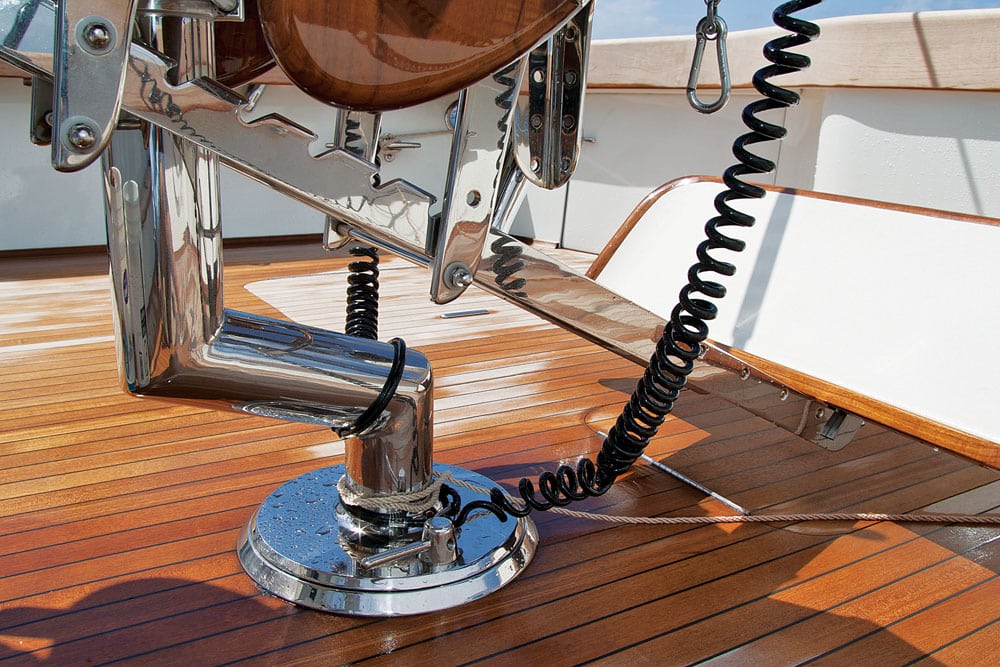
The fishing fighting chair starts with the seat, where the wood is cut and glued together in a special press, the grain of the top piece running fore-and-aft and the bottom piece running port-to-starboard to ensure a strong and sturdy foundation. “At this point it’s called a cookie,” Peters says. “Then it goes to the CNC [computer numerical control] machine, which cuts the shape and profile of the seat.” While that’s being done the chair, arms are cut from blanks; then they also head to the CNC for profiling, along with the rocket launcher. “The pieces move through assembly as a unit,” Peters says. “Other builders will use different arms with different chairs, but we do everything as one specific chair.”
Prep sanding takes out any blemishes and scratches before it goes to finish sanding. “One of the keys to a good-looking chair with a beautiful finish is in the sanding,” Peters says. Between all of the cutting, sanding and the multiple applications of the base coat and build-up finish, it’s a very labor-intensive process that takes more than 80 man-hours to complete. And because the finish tends to shrink a bit, the coated parts must then go to a waiting room to fully cure. At this point the pieces are ready for final assembly: The spindle is attached, along with the corner and footrest brackets, the rod cups, striking holders and other hardware.
The final builder installs the footrest and rocket launcher and tweaks the setup until it’s perfect. The finished chair is checked and rechecked for quality control before it’s wrapped, placed on a pallet, boxed in cardboard and shipped standing upright to the end customer, whether that’s a boatbuilder or private owner.
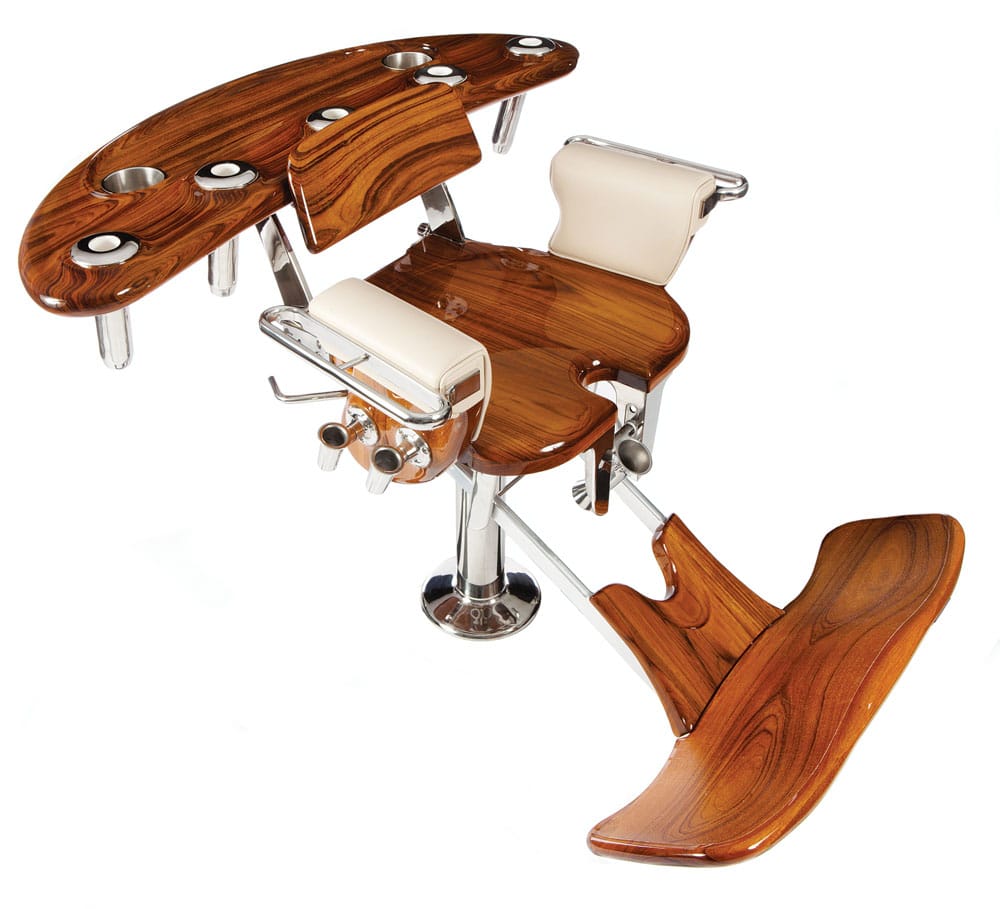
Pompanette Fighting Chairs
Started as a tackle company in Dania Beach, Florida, in 1949, Pompanette consists of seven different companies in the marine industry, with manufacturing located in Tampa, Florida, and Charlestown, New Hampshire, and showroom, sales and service facilities in Fort Lauderdale, Florida, and Newport Beach, California. They leverage their strong vertical integration and bicoastal reach to good effect with a very short turnaround time and the ability to do custom work.
Product manager Joe Ferrulle says this means that big things can happen very quickly. “We have a team of engineers that can design just about anything an owner can dream of and with our production, we can get that product built and installed in as little as three weeks,” he says. And with a worldwide network of dealers and distributors, service after the sale is a snap.
One of the products coming out of Pompanette should help owners of very large sport-fishermen. As the boats get bigger, it’s getting harder to set up a chair that allows the angler to clear the corners of the cockpit with the line. Until now, the solution has been an offset pedestal, but Pompanette Vice President Jim McDonnell says they are now building a better mousetrap. “The problem with the standard offset has been controlling it, especially when it’s rough,” he says. “We’ve developed a fully hydraulic control system for the chair, where a deckhand can easily maneuver it using a joystick control pad.”
For those who prefer manual control, Pompanette also has a setup that utilizes an indexed locking base with a kick-plate foot control. Developed with the assistance of heavy-tackle expert and heavy-tackle expert Capt. Peter B. Wright, the kick-plate control system allows the mate manning the chair to move the pedestal into predetermined positions by bumping a baseplate lever with his foot. Once locked into place, he can then swivel the top of the Pompanette fighting chair. It’s a great solution to an ongoing issue with bigger boats.
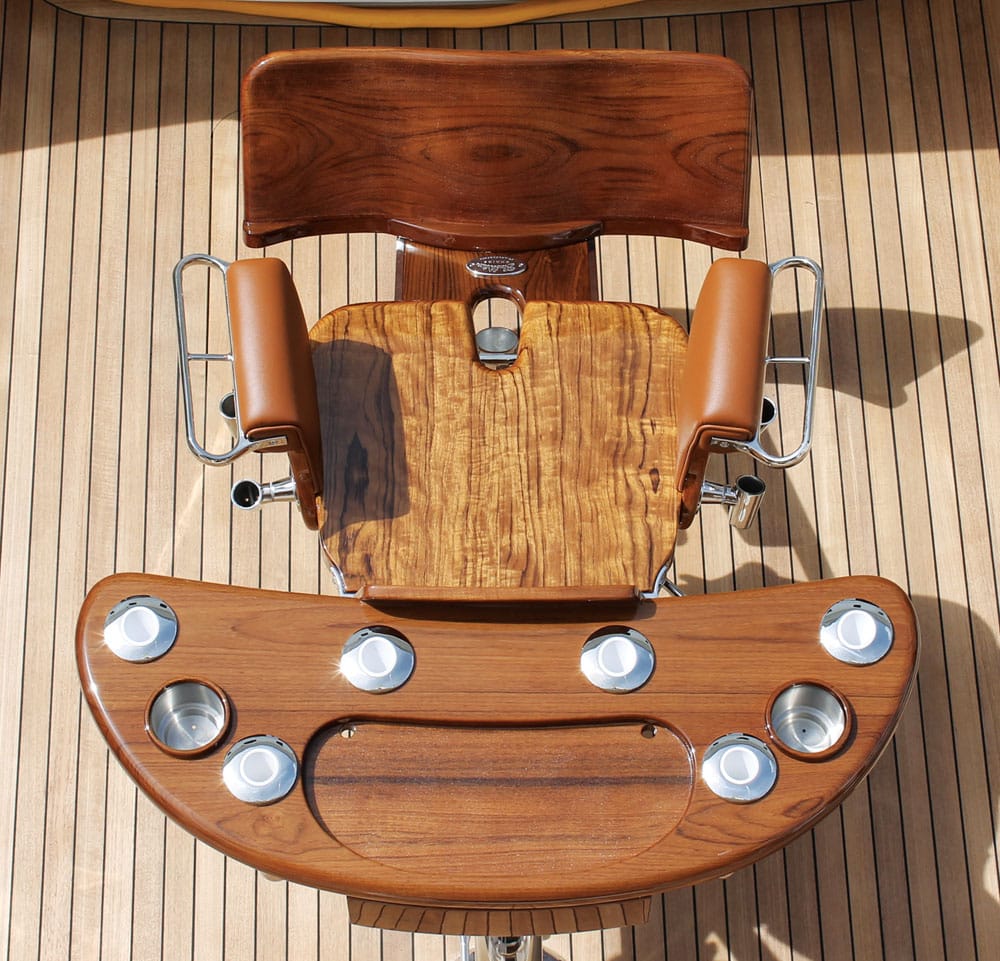
Fishing Fighting Chairs Upgrades
Bluewater Chairs is another builder that specializes in custom work in addition to its regular line of chairs and accessories. Because of the company’s location in Fort Lauderdale, it has the ability to work with many of the local boatbuilders on special projects in addition to doing one-off custom work, which it has done since its inception in 1988.
General manager Ben Smith says that rather than relying on a CNC machine, their chairs are built completely by hand one at a time. “The wood comes in through one end of the building; our showroom and offices are in the middle, and the finishing shop is on the other side,” he says. “Everything flows right through.”
He says their teak comes from Indonesia rather than South America. “Our wood has been kiln-dried and processed for over two years,” he says. “The South American teak can be very sappy, so it’s not usually up to the quality of what we need.” Bluewater has also built a strong reputation for its refinishing and service work on all brands of chairs and equipment.
One area where chair design has seen a big shift in the last few years is in the addition of a rocket launcher to the backrest. Traditional fighting chairs featured a ladder-style backrest that was adjustable or removable altogether; today, most prefer the additional rod storage, integrated rigging station and tackle drawer featured in a rocket-launcher setup. “Of all the chairs we built last year, I think we only made two with the traditional-style back,” says Release Marine’s Sam Peters.
But Frank Murray disagrees with the new trend. “I’d rather have the straight back, especially if you’re heavy-tackle fishing,” he says. “People start hanging all this stuff on the back of the chair, and it just gets in the way and makes it harder to maneuver around. Sometimes the old ways are best.”
In addition to beautiful fighting chairs, each manufacturer also builds accessories, such as helm chairs, step boxes and even marine furniture. Each offers a lot more than fighting chairs, so be sure to check out their websites for complete product lineups.
No matter who builds it, fighting chairs are functional works of art. They allow anglers to use far heavier tackle with much heavier drag settings, which means shorter fight times that are better for the fish, the angler and the number of hookups you can get in before it’s time to quit and head home.
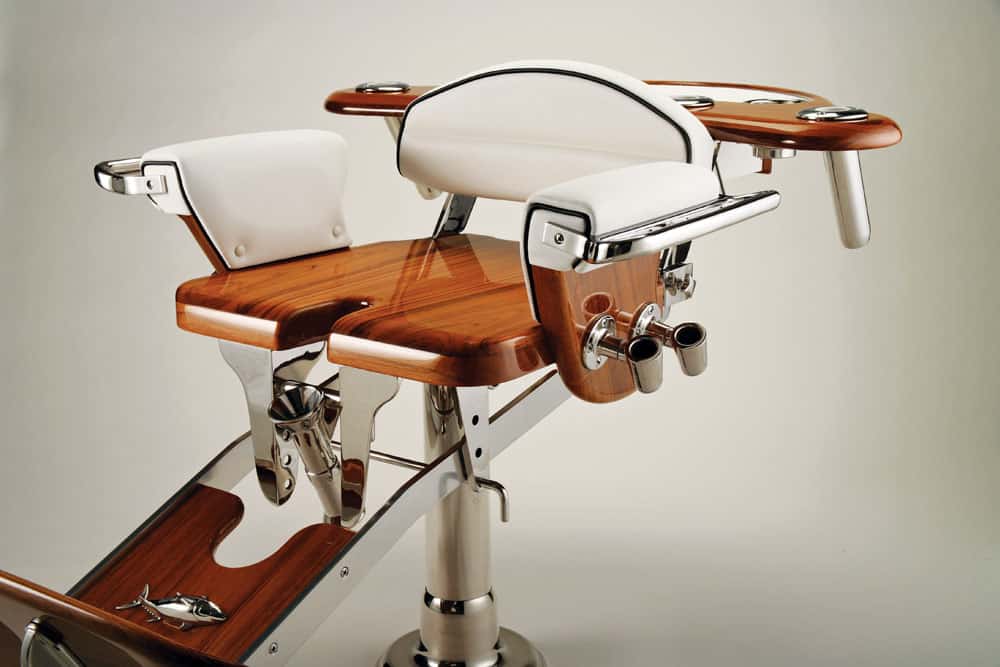
Taking Care of Your Fighting Chair
Because of their exposed position in the center of the cockpit, fighting chairs receive a tremendous amount of abuse, mostly from the sun but also from the rigors of sport fishing. Here are a few tips on keeping your chair looking good.
Have you ever seen what the sun can do to the dashboard of a car? To keep your chair from crackling in the sun, make sure it is covered whenever possible. Just be sure to pull the cover off occasionally and give the chair a good cleaning, as the cover can also trap and hold salt and grime against the chair’s surfaces. Cockpit shade covers also help keep the sun off the chair, especially if the boat’s going to be left unattended for any length of time.
Always keep the chair clean and waxed. Release Marine President Sam Peters recommends a metal insulating wax for stainless steel parts and an automotive-style wax for wood surfaces. “If you see water spots or rings, you’re not waxing enough,” he says. Peters also recommends pulling the chair off the base every few months to check it. “We’ve pulled apart some offset stanchions that had an inch and a half of pure salt in the base,” he says. “Be sure to use a nonpetroleum-based grease because any petroleum-based products can cause the Delrin bearings to swell — it’s critical to be sure to use the right grease in those bases.”
When in doubt, always check with the manufacturer of your particular chair for their recommendations on maintenance.
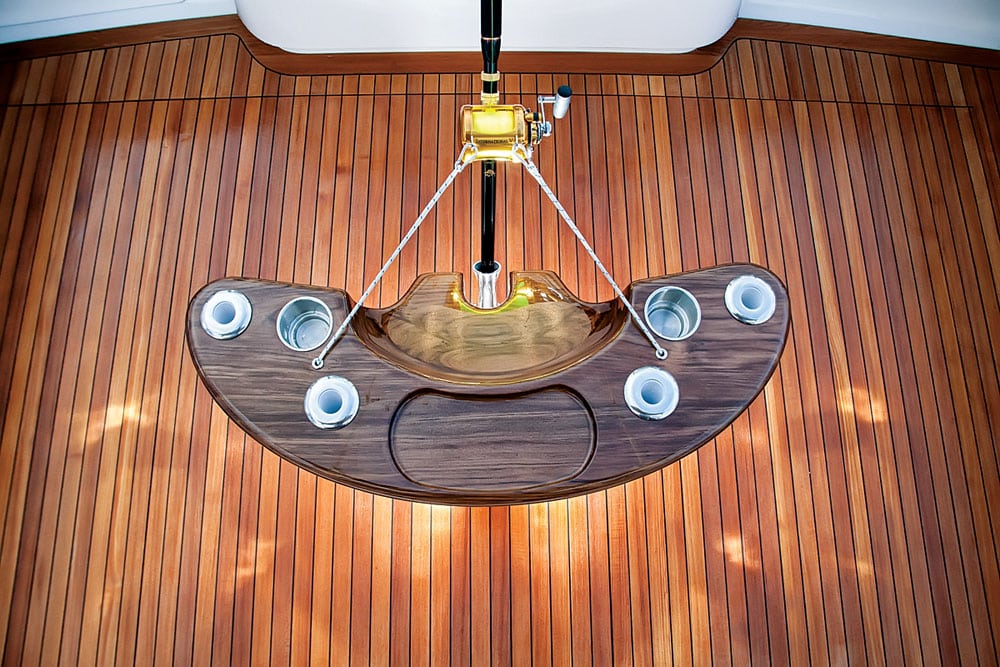
Alternatives to the Fighting Chair
There are some great alternatives to a full-size fighting chair. Perhaps the most revolutionary design is the Battle Saddle from Release Marine. This unique design combines the rod capacity of a rocket launcher with the ability to stabilize the angler and utilize a gimbal holder for the rod. It has integrated, adjustable harness lines too — it isn’t considered legal by the International Game Fish Association, but it will help anglers from kids to retirees use heavy tackle in rough seas. Bluewater Chairs has its own version called the Battle Station, which enables the angler to use a footrest for additional leverage.
Sailfish anglers don’t need a chair taking up valuable cockpit real estate, so they prefer a rocket launcher setup. This allows for multiple rods, as well as kite rods, to be close at hand.
